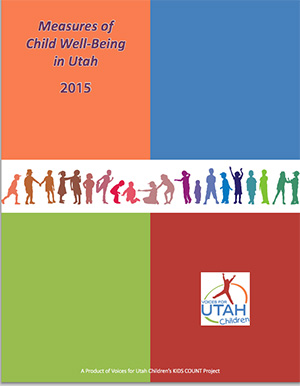Kids Count
A Tale of Two Utahs: How do Urban and Rural Utah Measure Up?
 It is widely agreed that rural communities have a different set of issues than more urban communities. While all low-income families, regardless of where they live, need connections to support programs and access to economic opportunities, strategies that work in urban areas often cannot be applied to rural areas where social and economic programs are few and far between.
It is widely agreed that rural communities have a different set of issues than more urban communities. While all low-income families, regardless of where they live, need connections to support programs and access to economic opportunities, strategies that work in urban areas often cannot be applied to rural areas where social and economic programs are few and far between.
Because access to services is such an important issue in Utah’s rural areas, it is imperative that policymakers and service providers have a clear view of the problems facing rural communities. In Voices for Utah Children’s annual publication Measures of Child Well-Being in Utah, a variety of child well-being indicators are presented at the county level. These indicators cover important milestones in areas such as economic security, education, and health.
This edition of Data Links explores several of the indicators annually presented in Measures to see how much or if child well-being differs in rural communities as compared to urban communities.
DEFINING URBAN AND RURAL
 There are a myriad of definitions for “urban” and “rural” from a variety of sources. For the purposes of this report we have chosen to use three categories based on the American Community Survey’s three breakdowns for the one year, three year and five year estimates:
There are a myriad of definitions for “urban” and “rural” from a variety of sources. For the purposes of this report we have chosen to use three categories based on the American Community Survey’s three breakdowns for the one year, three year and five year estimates:
Urban Areas - Areas with populations of 65,000+
Urban/Rural - Areas with populations of 64,999 to 20,000
Rural Areas - Areas of population 20,000 and under
Counties included in each area are indicated in the box to the right.
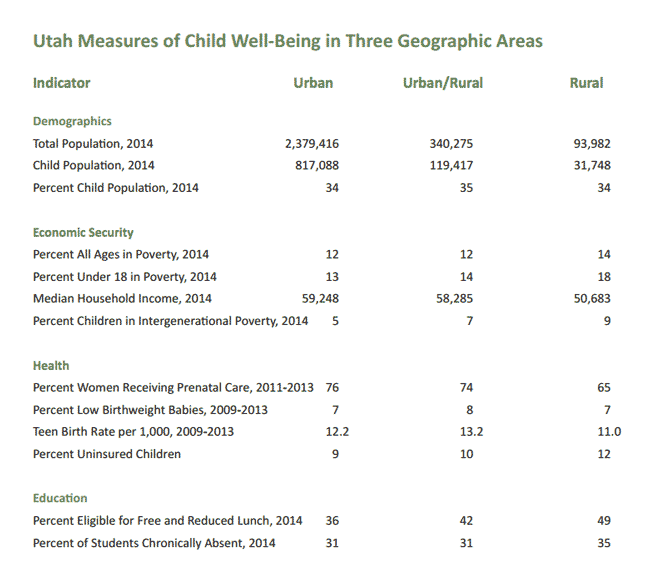

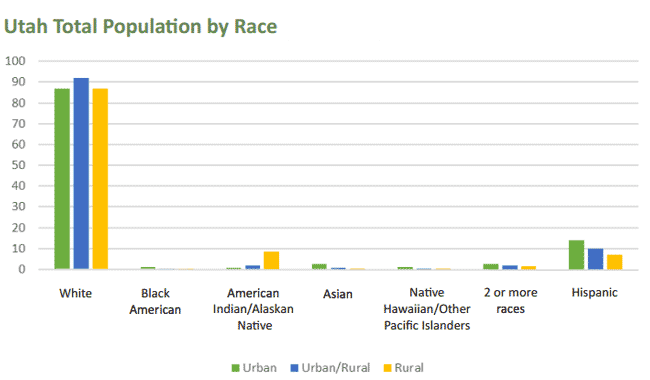
CONCLUSION
This data brief started out by saying it is widely agreed that rural communities have a different set of issues than urban communities. Access to services is difficult for a variety of reasons including lack of transportation and a lack of service providers. When there are no providers in town and individuals must wait on availability, scheduling can become a problem. In some cases where an individual has no family leave policy, traveling to a provider can mean missed wages. Child well-being indicators for children in rural Utah are, in general, slightly worse than those in urban areas. This makes all the above issues even more pressing and an area of concern that needs to be addressed.
“In urban areas, questions of access to care often revolve around whether all segments of the population have access to the full range of specialized medical centers serving the metropolitan area. In rural areas, the issue is often whether there are any health care facilities and providers to access at all. Large metropolitan counties have nearly four times as many physicians per 100,000 residents as do rural counties with only small towns."
Demographic Trends in Rural and Small Town America KENNETH JOHNSON, Carsey Institute Reports on Rural America 01/2006
Printer-friendly report:
![]() A Tale of Two Utahs: How do Urban and Rural Utah Measure Up?
A Tale of Two Utahs: How do Urban and Rural Utah Measure Up?
(Sources and definitions are available in the printer-friendly version of this report.)
 March 31, 2016 is Love UT Give UT!
March 31, 2016 is Love UT Give UT!
It’s a day for Utahns to give to the nonprofits that make Utah special. Every donation to Voices for Utah Children through Love UT Give UT gives Voices a chance to win matching grants and prizes.
And you don't have to wait! Donate now at http://bit.ly/loveUTchildren.
For 30 years now, Voices for Utah Children has called on our state, federal and local leaders to put children’s needs first. But the work is not done. The children of 30 years ago now have children of their own. Too many of these children are growing up in poverty, without access to healthcare or quality educational opportunities.
How can you be involved?
Make a tax-deductible donation to Voices for Utah Children—or join our Network with a monthly donation of $20 or more. Network membership includes complimentary admission to Network events with food, socializing, and opportunity to meet child advocacy experts. And don't forget to join our listserv to stay informed!
We look forward to the future of Voices for Utah Children and we hope you will be a part of our next 30 years.
Special thanks to American Express for sponsoring our 30th Anniversary Year. 
A Comparison of Utah’s Hispanic and Non-Hispanic White Children and Families
 For 30 years, Voices for Utah Children has been working on issues facing children in the areas of juvenile justice, child welfare, economic stability, education and health. We have become increasingly concerned about racial disparities in all these areas.
For 30 years, Voices for Utah Children has been working on issues facing children in the areas of juvenile justice, child welfare, economic stability, education and health. We have become increasingly concerned about racial disparities in all these areas.
Gathering and analyzing racial and ethnic data is the first step in making informed policy decisions. Those decisions must be guided by comprehensive, regularly updated data. Parsing data through racial and ethnic lenses uncovers patterns and trends that can assist in planning more responsive programs and services.
This Data Link compares Utah’s Hispanic children to white, non-Hispanic children with the goal of helping policymakers develop strategies that eliminate racial disparities and lead to improved child and family outcomes for all Utah’s children.
In 2014 there were 154,419 Hispanic or Latino children under the age of 18 in Utah. They make up 17% of the state’s children. As you can see from the data, these children are more at-risk for poor outcomes than their white non-Hispanic peers.
View the complete report:
For 30 years now, Voices for Utah Children has called on our state, federal and local leaders to put children’s needs first. But the work is not done. The children of 30 years ago now have children of their own. Too many of these children are growing up in poverty, without access to healthcare or quality educational opportunities. How can you be involved?
- Celebrate the 30th Anniversary of Voices for Utah Children with us at our Children’s Champion Award Luncheon on September 30, 2015.
- Make a tax-deductible donation to Voices for Utah Children—or join our Network with a monthly donation of $20 or more. Network membership includes complimentary admission to the luncheon.
We look forward to the future of Voices for Utah Children and we hope you will be a part of our next 30 years.
Special thanks to American Express for sponsoring our 30th Anniversary Year. 
Attendance and the Early Grades: A Two-Generation Issue
Chronic Absence is a Two-Generation Problem
Policies that help parents keep kids in school, such as family leave policies and effective transportation systems; coupled with programs that help the child, such as attention to bullying; and improved policies at the school level, such as collecting the right data and working with families to identify barriers to school attendance will ensure that every child succeeds.
"The reality is an absence is an absence, excused or not, and that child is not in that classroom benefiting from the instruction on that day. We have to work in our community, with our schools and our families to build a culture of attendance."
Ralph Smith, Executive Vice President, Annie E. Casey Foundation
Attendance and the Early Grades: A Two Generation Issue
Chronic absence, missing 10 percent of the school year or more, is an early warning indicator of academic trouble for students and later;dropout. Excused and unexcused absences easily add up to too much time lost in the classroom. Students are at risk academically if they miss 10 percent of the school year, or about 18 days. Once too many absences have occurred, it affects learning, regardless of whether absences are excused or unexcused.
The map below shows the percent of elementary school students who were chonically absent in school year 2013. On average, no district had less than 90 percent of their students absent on a given day, despite exceptionally high rates of chronic absence in some schools and districts. Clearly, average daily attendance can mask a chronic absence problem.
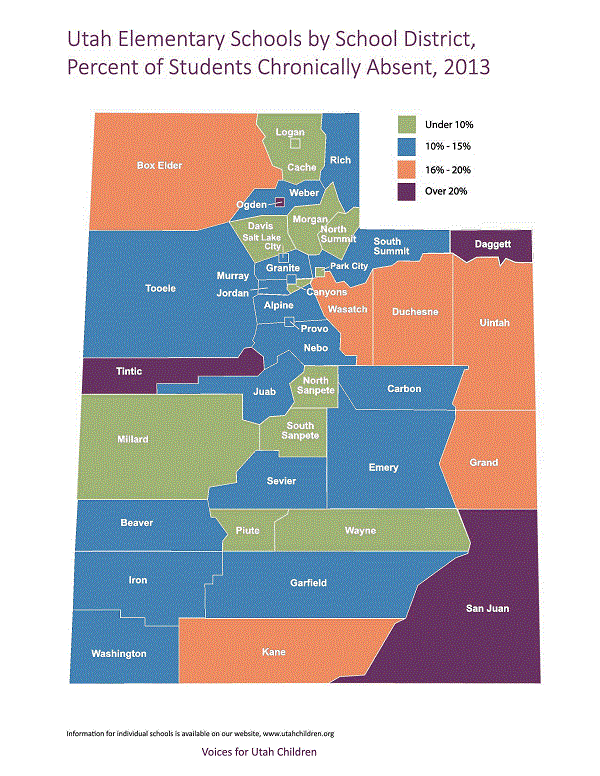
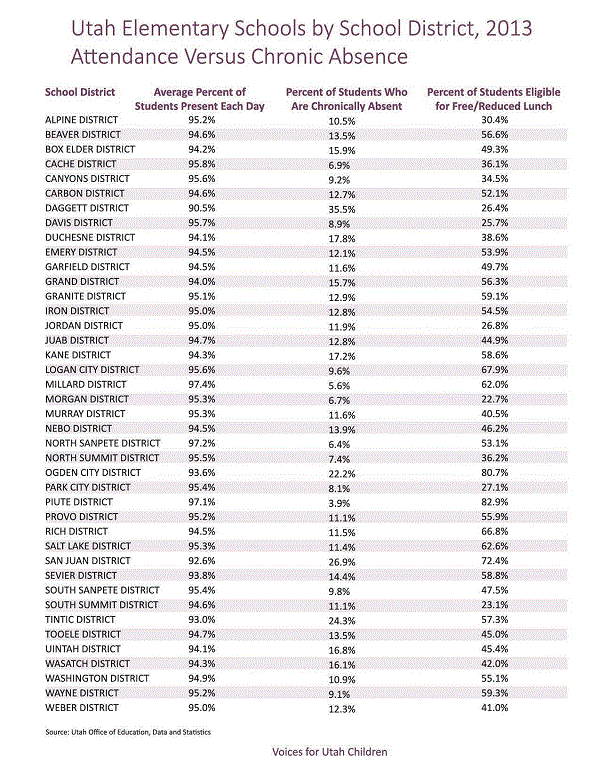
Reducing chronic absence can help close achievement gaps. Chronic absence especially affects achievement for low-income students who depend more on school for opportunities to learn. Because they are more likely to face systemic barriers to getting to school, low-income children, many of whom are children of color, have higher levels of chronic absence starting as early as kindergarten.
A 2012 research brief by the Utah Education Policy Center that looked at the percent of chronically absent students by school year, found that kindergarten and first grade students tended to be chronically absent more often than their older elementary school peers. Further, on average, being chronically absent in one grade increased the odds of being chronically absent in the next grade by nearly 13 times. For each year that a student was chronically absent, his or her odds of dropping out nearly doubled. Studies from multiple states have shown that chronically absent high school students are less likely to graduate. Improving student attendance is an essential, cost-effective but often overlooked two-generation strategy for ensuring that students are on-track to learn and succeed, and to decrease the chance of living in poverty as adults.
Chronic absence does not just affect the students who miss school. If too many students are chronically absent, it slows down instruction for other students, who must wait while the teacher repeats material for absentee students. This makes it harder for students to learn and teachers to teach.
CHRONIC ABSENCE IS A RESULT OF A COMBINATION OF FACTORS: SCHOOL, FAMILY AND COMMUNITY
All schools enroll some students who have injuries or illnesses leading to frequent absences, and schools should know who these students are and design individual strategies to support them. Schools where five percent of students are chronically absent do not have systemic attendance failures. However, in schools where 20 percent of students are chronically absent, the extent to which schools, families and communities each might play a contributing role needs to be considered.
While illness is a leading factor in chronic early absence, others such as poverty, teenage parenting, single parenting, low maternal education levels, unemployment, poor maternal health, and household food insecurity all can affect school attendance. The 2012 Utah Education Policy Center Policy research brief found that students from low-income homes were 90 percent more likely to be chronically absent. Students who are absent from school miss opportunities to learn and develop positive relationships within the school community. During the early elementary school years, children develop important skills and approaches to learning that are critical for ongoing school success. Through their experiences in K-3 classrooms, children build academic, social-emotional and study skills. Children who are chronically absent in kindergarten show lower levels of achievement in math, reading and general knowledge in first grade.
Children who are homeless or formerly homeless experience poor educational outcomes related to school absenteeism and mobility. Other families may be dealing with serious problems (e.g. mental illness, child or domestic abuse, incarceration of a parent, etc.) that make school attendance difficult because family life has been disrupted and public agencies and schools lack a coordinated response.
Chronic absenteeism also can result from poor quality education, ambivalence about or alienation from school, and chaotic school environments, including high rates of teacher turnover, disruptive classrooms and/or bullying.
Improving student attendance is an essential, cost-effective but often overlooked strategy for ensuring our students are on-track to learn and succeed. While addressing some attendance barriers- such as health, poor transportation, and unstable housing- can require longer-term strategies, everyone can make a difference by helping students and families understand that going to school every day and avoiding absences whenever possible is critical to realizing success in school and success in life.
Voices for Utah Children is proud to be a part of the Aspen Institute Ascend Network. The goal of the Aspen Institute Ascend Network is to mobilize empowered two-generation organizations and leaders to influence policy and practice changes that increase economic security, educational success, social capital, and health and well-being for children, parents, and their families. Learn more at http:/ /ascend.aspeninstitute.org/network
Utah Kids Count Data Book
Current Utah KIDS COUNT Data Book
Measures of Child Well-Being, 2015
Previous Utah KIDS COUNT Data Books
KIDS COUNT Policy Reports
Creating Opportunity for Families: A Two-Generation Approach, 2014
Early Reading Proficiency in the United States, 2014
The First Eight Years: Giving Kids a Foundation for Lifetime Success, 2013
Utah Data Briefs
& Other Utah Data Products
A Two-Generation Strategy: Healthy Parents and Healthy Kids, 2014
Attendance and the Early Grades: A Two-Generation Issue, 2014
A Two-Generation Strategy: Right from the Start, 2014
A Two-Generation Approach to Ending Poverty in Utah, 2014
Kids Count in Utah Poster, 2013
Utah's Poverty Data at a Glance, 2009
Risk Factors Among Children in Utah, 2009
Teen Pregnancy Issue Brief, 2008
Basic Family Budgets: How Much Does It Take To Get By, 2007
Then and Now: Ten Years of Child Well-Being in Utah, 2005




